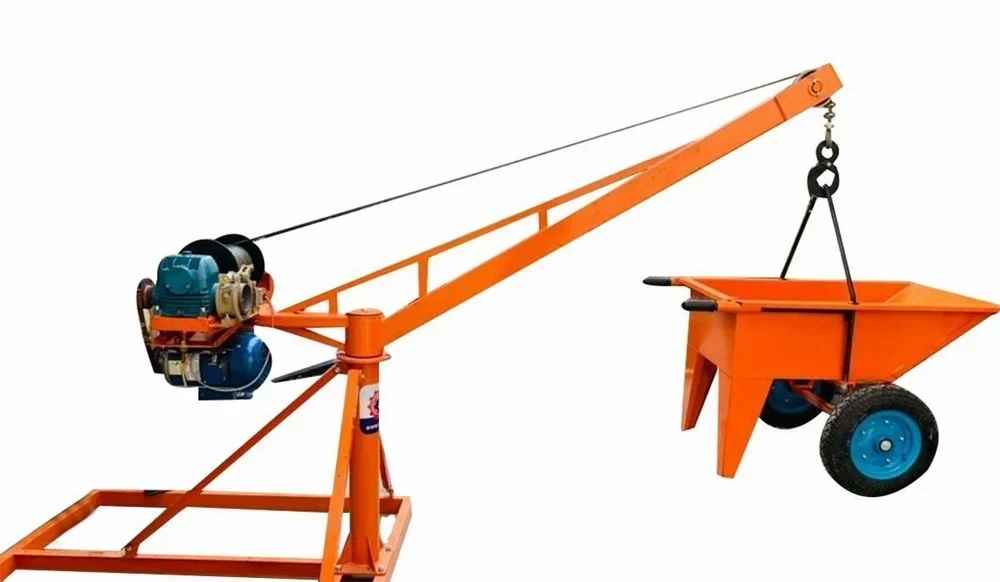Description
A "monkey lift" machine is another term for a material hoist, or a personnel/material hoist commonly used in construction and industrial settings.
Design and Structure: Monkey lifts are usually compact in size and designed to be easily movable around a construction site. They often feature a vertical mast with a platform or cage attached to it.
Functionality: These machines are primarily used for lifting materials and sometimes personnel to elevated heights. They can handle various loads, including construction materials like bricks, mortar, steel beams, and tools.
Power Source: Monkey lifts can be powered by electricity, battery, or even manual operation (depending on the model). Electric and battery-powered versions are common for efficiency and ease of use.
Safety Features: Safety is a key aspect of monkey lift machines. They typically come equipped with features such as overload protection, emergency stop buttons, limit switches to prevent over-travel, and safety rails or cages to protect personnel.
Versatility: Monkey lifts are versatile and can be used indoors and outdoors. They are often used in construction of buildings, installation of windows, maintenance work, and other tasks that require lifting heavy loads to different heights.
Control Mechanism: Many modern monkey lifts come with remote control options, allowing operators to control lifting and movement from the ground or a safe distance.
Capacity: Depending on the model and design, monkey lifts can have varying load capacities and lifting heights, accommodating different project needs.
A Monkey Lift Machine, also known as a Monkey Hoist, is an essential material handling solution widely used in the construction industry for vertically transporting materials such as bricks, cement, sand, and steel bars to various floors of a building. Its compact design, ease of operation, and adaptability to different site conditions make it a preferred choice for builders and contractors.
🛠️ Technical Specifications
Monkey lifts come in various configurations to suit different construction needs. Here are some common specifications:
-
Load Capacity: Typically ranges from 200 kg to 500 kg, accommodating various material weights.
-
Lifting Height: Capable of reaching heights up to 130 feet (approximately 40 meters), suitable for multi-story buildings.
-
Motor Power: Equipped with electric motors ranging from 3 HP to 7.5 HP, ensuring efficient lifting operations.
-
Power Supply: Designed to operate on single-phase or three-phase electric power, providing flexibility based on site requirements.
-
Boom Length: Standard boom lengths are around 5.5 feet, constructed from durable materials to handle the stresses of lifting.
-
Wire Rope: Utilizes high-strength wire ropes, such as 10 mm Mahadev or Usha Martin ropes, ensuring safety and reliability.
-
Rotation: Features a 360-degree rotation capability, allowing for easy maneuvering and placement of materials.
✅ Key Features and Benefits
-
Compact and Portable: The monkey lift's design allows for easy transportation and installation, even in confined construction sites.
-
User-Friendly Operation: Simple controls and mechanisms make it accessible for operators with varying skill levels.
-
Enhanced Safety: Incorporates safety features such as reliable braking systems and sturdy construction to prevent accidents.
-
Versatility: Suitable for lifting a wide range of construction materials, making it a versatile tool on the job site.
-
Cost-Effective: Reduces manual labor requirements and increases efficiency, leading to cost savings in the long run.
🏗️ Applications
Monkey lifts are predominantly used in:
-
Residential and Commercial Building Construction: Transporting materials to various floors.
-
Industrial Projects: Handling heavy components and equipment.
-
Renovation Works: Facilitating the movement of materials in existing structures.


 Brochure
Brochure Call Us
Call Us Whatsapp Now
Whatsapp Now